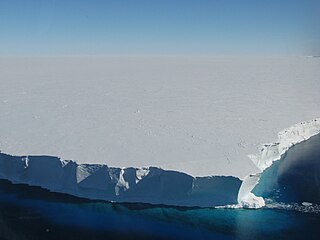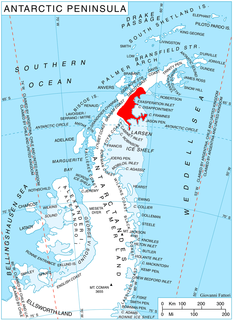
Hammond Glacier is located on the northeast side of the Haines Mountains, flowing northwest for about 40 nautical miles (70 km) to Sulzberger Ice Shelf in the Ford Ranges of Marie Byrd Land, Antarctica. It was discovered in 1934 by the Byrd Antarctic Expedition, and named by Richard E. Byrd for John Hays Hammond, an American mining engineer and philanthropist.

Lambert Glacier is a major glacier in East Antarctica. At about 60 miles (100 km) wide, over 250 miles (400 km) long, and about 2,500 m deep, it holds the Guinness world record for the world's largest glacier. It drains 8% of the Antarctic ice sheet to the east and south of the Prince Charles Mountains and flows northward to the Amery Ice Shelf. It flows in part of Lambert Graben and exits the continent at Prydz Bay.

Mertz Glacier is a heavily crevassed glacier in George V Coast of East Antarctica. It is the source of a glacial prominence that historically has extended northward into the Southern Ocean, the Mertz Glacial Tongue. It is named in honor of the Swiss explorer Xavier Mertz.

Beaver Glacier is a glacier about 15 miles (24 km) long and 4 miles (6 km) wide, flowing west into Amundsen Bay between Auster Glacier and Mount Gleadell. The head of Beaver Glacier is located very close to the base of Mount King in Enderby Land. It was visited by an Australian National Antarctic Research Expeditions (ANARE) party on October 28, 1956, and named after the Beaver aircraft used by ANARE in coastal exploration.

Assender Glacier is a glacier flowing west into Spooner Bay in Enderby Land, Antarctica. It was plotted from air photos taken from Australian National Antarctic Research Expeditions aircraft in 1956, and named by the Antarctic Names Committee of Australia for Pilot Officer Ken J. Assender, RAAF, pilot at Mawson Station in 1959.
The Land Glacier is a broad, heavily crevassed glacier, about 35 nautical miles (60 km) long, descending into Land Bay in Marie Byrd Land, Antarctica. It was discovered by the U.S. Antarctic Service (1939–41) and named for Rear Admiral Emory S. Land, Chairman of the U.S. Maritime Commission.

Flask Glacier, is a gently-sloping glacier, 25 nautical miles long, flowing east from Bruce Plateau to enter Scar Inlet between Daggoo Peak and Spouter Peak in Graham Land, Antarctica. The lower reaches of this glacier were surveyed and photographed by the Falklands Islands Dependencies Survey (FIDS) in 1947. The entire glacier was photographed by the Falkland Islands and Dependencies Aerial Survey Expedition in 1955–56, and mapped by the FIDS in 1957. It was named by the UK Antarctic Place-names Committee after the third mate on the Pequod in Herman Melville's Moby-Dick; or, The White Whale.

Posadowsky Glacier is a glacier about 9 nautical miles long, flowing north to Posadowsky Bay immediately east of Gaussberg. Posadowsky Bay is an open embayment, located just east of the West Ice Shelf and fronting on the Davis Sea in Kaiser Wilhelm II Land. Kaiser Wilhelm II Land is the part of East Antarctica lying between Cape Penck, at 87°43'E, and Cape Filchner, at 91°54'E, and is claimed by Australia as part of the Australian Antarctic Territory. Other notable geographic features in this area include Drygalski Island, located 45 mi NNE of Cape Filchner in the Davis Sea, and Mirny Station, a Russian scientific research station.

Wilson Glacier is a glacier 9 nautical miles (17 km) long, flowing northeast into Edward VIII Ice Shelf just south of Seaton Glacier. Photographed from ANARE aircraft in 1956. Named by Antarctic Names Committee of Australia (ANCA) for Flight Lieutenant H.O. Wilson, RAAF pilot at Mawson Station, 1959, who was killed in an aircraft accident shortly after his return to Australia.

Apfel Glacier is a glacier about 5 nautical miles (10 km) wide and 20 nautical miles (40 km) long, flowing west-northwest along the south flank of the Bunger Hills and terminating in Edisto Ice Tongue. It was mapped from air photos taken by U.S. Navy Operation Highjump, 1946–47, and named by the Advisory Committee on Antarctic Names for Earl T. Apfel, professor of geology at Syracuse University, who served as geologist with the U.S. Navy Operation Windmill parties, 1947–48, which established astronomical control stations along Queen Mary, Knox and Budd Coasts.

Barnes Glacier is a glacier on the west side of Hemimont Plateau flowing west into Blind Bay on the west coast of Graham Land. It was named by the UK Antarctic Place-Names Committee in 1958 for Howard T. Barnes, Canadian physicist and pioneer of ice engineering.

Charybdis Glacier is a large glacier which drains northeast between the Porthos Range and the Aramis Range of the Prince Charles Mountains to the west side of the Amery Ice Shelf. It was discovered by an Australian National Antarctic Research Expeditions southern party led by W.G. Bewsher in December 1956 and named after whirpool monster Charybdis because of the considerable difficulty experienced in traversing this region due to the glacier.

Childs Glacier is a glacier in the Neptune Range of the Pensacola Mountains, draining westward from Roderick Valley to enter Foundation Ice Stream. It was mapped by the United States Geological Survey from surveys and from U.S. Navy air photos, 1956–66, and named by the Advisory Committee on Antarctic Names for John H. Childs, a builder at Ellsworth Station, winter 1958.
The Condon Hills are a group of hills rising to 840 metres (2,760 ft) along the east side of Rayner Glacier, Enderby Land. They were plotted from air photos taken by Australian National Antarctic Research Expeditions in 1956 and 1957, and named by the Antarctic Names Committee of Australia for M.A. Condon, Assistant Director, Bureau of Mineral Resources, Canberra, Australia.
Sunker Nunataks is a group of small, rounded nunataks rising through the ice on the east side of Northwind Glacier, similar in appearance to a reef at sea, in the Convoy Range, Victoria Land. So named by a 1989-90 New Zealand Antarctic Research Program (NZARP) field party. In Newfoundland fisherman's parlance, a sunker is a rocky reef.
Fleming Glacier is a broad glacier 25 nautical miles (46 km) long on the west side of the Antarctic Peninsula, flowing west-northwest and terminating in Forster Ice Piedmont to the east of the Wordie Ice Shelf. The glacier was charted by the British Graham Land Expedition (BGLE) under John Rymill, 1934–37, and was photographed from the air by the United States Antarctic Service on September 29, 1940. This hitherto unnamed feature was named by the Advisory Committee on Antarctic Names in 1947 for Reverend W.L.S. Fleming, Dean of Trinity Hall, Cambridge University; also, chaplain, chief scientist, and geologist of the BGLE.

Hamilton Glacier is a glacier about 5 nautical miles (9 km) long draining northwest from Edward VII Peninsula south of Cape Colbeck, Antarctica. It was named by the Advisory Committee on Antarctic Names after Gordon S. Hamilton of the faculty, University of Maine, who was a theoretical and field researcher of ice motion in the West Antarctic ice stream area from the 1980s.

Hays Glacier is a glacier flowing north into the head of Spooner Bay, Enderby Land, Antarctica. It was plotted from air photos taken by the Australian National Antarctic Research Expeditions (ANARE) in 1956, and was named for J. Hays, a United States observer with the ANARE which made a landing nearby.

MacNamara Glacier is a glacier in the Patuxent Range of the Pensacola Mountains in Antarctica, draining northeastward between the Thomas Hills and Anderson Hills to Foundation Ice Stream. It was mapped by the United States Geological Survey from surveys and U.S. Navy air photos, 1956–66, and was named by the Advisory Committee on Antarctic Names for Edlen E. MacNamara, a United States Antarctic Research Program exchange scientist at Molodezhnaya Station, winter 1967.

Thyer Glacier is a tributary glacier, flowing northwest along the south side of the Raggatt Mountains to enter the Rayner Glacier. Mapped from ANARE air photos taken by the RAAF flight in 1956. Named by Antarctic Names Committee of Australia (ANCA) for R.F. Thyer, chief geophysicist, Bureau of Mineral Resources, Australian Department of National Development and Energy.













